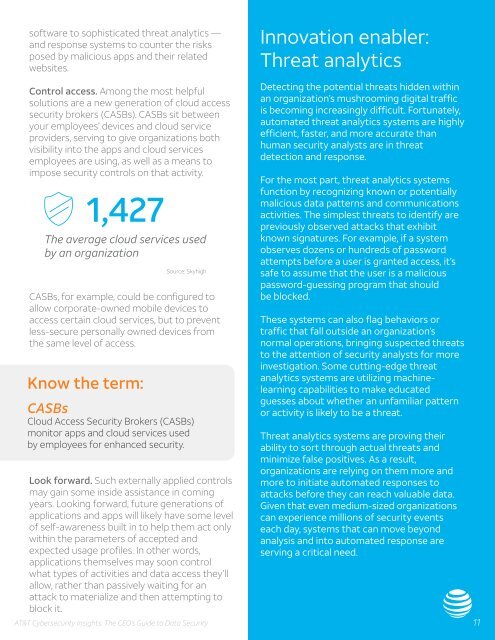The CEO’s Guide to Data Security
2mRmvHx
2mRmvHx
You also want an ePaper? Increase the reach of your titles
YUMPU automatically turns print PDFs into web optimized ePapers that Google loves.
software <strong>to</strong> sophisticated threat analytics —<br />
and response systems <strong>to</strong> counter the risks<br />
posed by malicious apps and their related<br />
websites.<br />
Innovation enabler:<br />
Threat analytics<br />
Control access. Among the most helpful<br />
solutions are a new generation of cloud access<br />
security brokers (CASBs). CASBs sit between<br />
your employees’ devices and cloud service<br />
providers, serving <strong>to</strong> give organizations both<br />
visibility in<strong>to</strong> the apps and cloud services<br />
employees are using, as well as a means <strong>to</strong><br />
impose security controls on that activity.<br />
1,427<br />
<strong>The</strong> average cloud services used<br />
by an organization<br />
Source: Skyhigh<br />
CASBs, for example, could be configured <strong>to</strong><br />
allow corporate-owned mobile devices <strong>to</strong><br />
access certain cloud services, but <strong>to</strong> prevent<br />
less-secure personally owned devices from<br />
the same level of access.<br />
Know the term:<br />
CASBs<br />
Cloud Access <strong>Security</strong> Brokers (CASBs)<br />
moni<strong>to</strong>r apps and cloud services used<br />
by employees for enhanced security.<br />
Look forward. Such externally applied controls<br />
may gain some inside assistance in coming<br />
years. Looking forward, future generations of<br />
applications and apps will likely have some level<br />
of self-awareness built in <strong>to</strong> help them act only<br />
within the parameters of accepted and<br />
expected usage profiles. In other words,<br />
applications themselves may soon control<br />
what types of activities and data access they’ll<br />
allow, rather than passively waiting for an<br />
attack <strong>to</strong> materialize and then attempting <strong>to</strong><br />
block it.<br />
Detecting the potential threats hidden within<br />
an organization’s mushrooming digital traffic<br />
is becoming increasingly difficult. Fortunately,<br />
au<strong>to</strong>mated threat analytics systems are highly<br />
efficient, faster, and more accurate than<br />
human security analysts are in threat<br />
detection and response.<br />
For the most part, threat analytics systems<br />
function by recognizing known or potentially<br />
malicious data patterns and communications<br />
activities. <strong>The</strong> simplest threats <strong>to</strong> identify are<br />
previously observed attacks that exhibit<br />
known signatures. For example, if a system<br />
observes dozens or hundreds of password<br />
attempts before a user is granted access, it’s<br />
safe <strong>to</strong> assume that the user is a malicious<br />
password-guessing program that should<br />
be blocked.<br />
<strong>The</strong>se systems can also flag behaviors or<br />
traffic that fall outside an organization’s<br />
normal operations, bringing suspected threats<br />
<strong>to</strong> the attention of security analysts for more<br />
investigation. Some cutting-edge threat<br />
analytics systems are utilizing machinelearning<br />
capabilities <strong>to</strong> make educated<br />
guesses about whether an unfamiliar pattern<br />
or activity is likely <strong>to</strong> be a threat.<br />
Threat analytics systems are proving their<br />
ability <strong>to</strong> sort through actual threats and<br />
minimize false positives. As a result,<br />
organizations are relying on them more and<br />
more <strong>to</strong> initiate au<strong>to</strong>mated responses <strong>to</strong><br />
attacks before they can reach valuable data.<br />
Given that even medium-sized organizations<br />
can experience millions of security events<br />
each day, systems that can move beyond<br />
analysis and in<strong>to</strong> au<strong>to</strong>mated response are<br />
serving a critical need.<br />
AT&T Cybersecurity Insights: <strong>The</strong> <strong>CEO’s</strong> <strong>Guide</strong> <strong>to</strong> <strong>Data</strong> <strong>Security</strong> 11<br />
11



